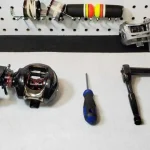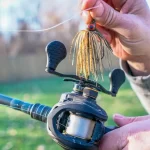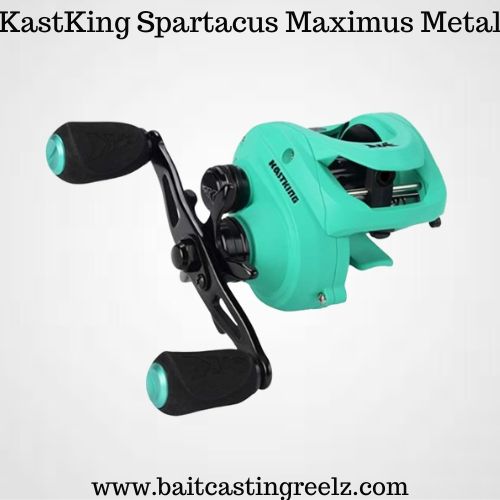Baitcasting reels are popular among anglers who want to fish with larger lures and heavier lines. They offer more control, accuracy, and power than spinning reels, and can handle big fish in tough conditions. However, baitcasting reels also require more skill and maintenance than spinning reels, and one of the most important aspects of using them is spooling them correctly.
Spooling a baitcaster reel means putting fishing line on the reel’s spool, which is the cylindrical part that holds and releases the line, which can improve your casting performance, prevent line twists and backlashes, and extend the life of your line and reel. Improper spooling of baitcasting reel can result in poor casting, line tangles, and frustration.
In this article, we will show you how to spool a baitcaster reel step by step, using different types of fishing lines: monofilament, fluorocarbon, and braid. We will also give you some tips and tricks to make the process easier and more efficient. By the end of this article, you will be able to spool your baitcaster reel like a pro and enjoy your fishing experience.
What You Will Need
Before you start spooling your baitcaster reel, you will need the following items:
- A baitcasting rod and reel
- A fishing line of your choice (monofilament, fluorocarbon, or braid)
- A pair of scissors or a line cutter
- A pencil or a screwdriver
- A friend or a line spooler (optional)
How to Spool a Baitcaster Reel with Monofilament or Fluorocarbon Line
Monofilament and fluorocarbon lines are the most common types of fishing lines used on baitcasting reels. They are similar in structure and performance, but have some differences in characteristics. Monofilament is cheaper, stretchier, more buoyant, and more visible than fluorocarbon. Fluorocarbon is more expensive, stiffer, denser, and less visible than monofilament.
Both monofilament and fluorocarbon lines can be spooled on a baitcaster reel using the same method. Here are the steps to follow:
Step 1: Attach Your Baitcaster Reel to Your Rod
The first step is to attach your baitcaster reel to your rod. This will help you to keep tension on the line and align it with the line guide of the reel. To attach your baitcaster reel to your rod, follow these steps:
- Loosen the locking nut on the reel seat of your rod.
- Insert the foot of your reel into the reel seat.
- Tighten the locking nut until the reel is firmly secured.
- Make sure that the handle of your reel is on the same side as your dominant hand.
Step 2: Feed the Line Through the First Guide of the Rod
The next step is to feed the line through the first guide of the rod. This is the metal ring that is closest to the handle of your rod. Feeding the line through the first guide will help you to run the line towards your reel from the right direction, and help you to apply tension to it during the spooling process.
To feed the line through the first guide of the rod, follow these steps:
- Take your fishing line out of its packaging and find its free end.
- Hold your rod with one hand and feed the free end of your line through the first guide with your other hand.
- Pull about two feet of line through the guide.
Step 3: Feed the Line Through the Line Guide of the Reel
The third step is to feed the line through the line guide of the reel. This is the small metal loop that moves from side to side on top of your reel when you turn the handle. Feeding the line through the line guide is essential, as it ensures that the line is filled evenly on to the spool.
To feed the line through the line guide of the reel, follow these steps:
- Hold your rod with one hand and use your other hand to open up the bail arm of your reel. The bail arm is a metal wire that flips up and down on one side of your reel.
- Feed the free end of your line through the line guide from behind.
- Close down the bail arm over your line.
Step 4: Tie The Line To The Spool Of Your Reel
The fourth step is to tie the line to the spool of your reel. The spool is the cylindrical part that holds and releases the line on your reel. Tying the line to the spool will secure it in place and prevent it from slipping.
To tie the line to the spool of your reel, follow these steps:
- If your baitcaster reel has holes in its spool, you can thread the line through two of the holes and then tie it down with a double overhand knot. A double overhand knot is a simple knot that you make by looping the line twice around itself and then pulling the free end through the loops.
- If your baitcaster reel does not have holes in its spool, you can wrap the line around the spool and tie it down with a double overhand knot.
- Trim off the excess line from the knot with your scissors or line cutter.
Step 5: Start Spooling The Line Onto The Reel By Turning The Handle
The fifth step is to start spooling the line onto the reel by turning the handle. This will wind the line onto the spool and fill up your reel. To start spooling the line onto the reel by turning the handle, follow these steps:
- Hold your rod with one hand and use your other hand to turn the handle of your reel clockwise.
- Keep tension on the line by holding it between your fingers or using a cloth. Do not pull too hard or too loose, as this can cause line twists or slack.
- Make sure that the filler spool rotates in the same direction as the reel spool, to avoid line twisting. You can do this by placing a pencil through the hole of the filler spool and stepping on one end of it, while resting the other end on your other foot. Alternatively, you can use a friend or a line spooler to hold the filler spool for you.
Step 6: Fill The Spool Until It Is Almost Full
The final step is to fill the spool until it is almost full. You do not want to overfill or underfill your spool, as this can affect your casting performance and cause problems. To fill the spool until it is almost full, follow these steps:
- Keep turning the handle and filling the line until there is about 1/8th inch gap between the edge of the spool and the line. This will prevent overfilling and backlash.
- Cut the line from the filler spool and attach your lure or hook.
If you are new to fishing and looking for baitcasting reel for you, have a look at Best Baitcasters For Beginners.
How to Spool a Baitcaster Reel with Braid Line
Braid line is another type of fishing line that can be used on baitcasting reels. It is made of multiple strands of synthetic fibers that are woven together to form a thin and strong line. Braid line has many advantages over monofilament and fluorocarbon lines, such as higher sensitivity, lower stretch, higher abrasion resistance, and longer casting distance.
However, braid line also has some disadvantages, such as higher cost, lower knot strength, higher visibility, and lower compatibility with some reels. Braid line also requires a different method of spooling than monofilament and fluorocarbon lines, as it can slip on the smooth surface of the spool.
To spool a baitcaster reel with braid line, you need to use a backing layer of monofilament or fluorocarbon line to prevent slippage. You also need to use a special knot to connect the braid line to the backing layer. Here are the steps to follow:
Step 1: Attach Your Baitcaster Reel to Your Rod
The first step is the same as for monofilament or fluorocarbon lines. You need to attach your baitcaster reel to your rod by loosening the locking nut on the reel seat, inserting the foot of your reel into the reel seat, tightening the locking nut, and making sure that the handle of your reel is on the same side as your dominant hand.
Step 2: Feed The Monofilament Or Fluorocarbon Line Through The First Guide Of The Rod
The second step is also similar to monofilament or fluorocarbon lines. You need to feed about two feet of monofilament or fluorocarbon line through the first guide of the rod. This will be the backing layer for your braid line.
Step 3: Feed The Monofilament Or Fluorocarbon Line Through The Line Guide Of The Reel
The third step is also similar to monofilament or fluorocarbon lines. You need to feed the free end of your monofilament or fluorocarbon line through the line guide of your reel from behind, and close down the bail arm over it.
Step 4: Tie The Monofilament Or Fluorocarbon Line To The Spool Of Your Reel
The fourth step is also similar to monofilament or fluorocarbon lines. You need to tie the monofilament or fluorocarbon line to the spool of your reel with a double overhand knot, and trim off the excess line from the knot.
Step 5: Start Spooling The Monofilament Or Fluorocarbon Line Onto The Reel
The fifth step is to start spooling the monofilament or fluorocarbon line onto the reel by turning the handle. This will create a thin layer of line on the spool that will prevent the braid line from slipping. To start spooling the monofilament or fluorocarbon line onto the reel, follow these steps:
- Hold your rod with one hand and use your other hand to turn the handle of your reel clockwise.
- Keep tension on the line by holding it between your fingers or using a cloth. Do not pull too hard or too loose, as this can cause line twists or slack.
- Make sure that the filler spool rotates in the same direction as the reel spool, to avoid line twisting. You can do this by placing a pencil through the hole of the filler spool and stepping on one end of it, while resting the other end on your other foot. Alternatively, you can use a friend or a line spooler to hold the filler spool for you.
- Fill about one-third of the spool with the monofilament or fluorocarbon line. This will be enough to provide a good backing for your braid line.
Step 6: Cut The Monofilament Or Fluorocarbon Line And Tie It To The Braid Line
The sixth step is to cut the monofilament or fluorocarbon line and tie it to the braid line. This will connect the two types of lines and allow you to fill the rest of the spool with braid line. To cut the monofilament or fluorocarbon line and tie it to the braid line, follow these steps:
- Cut the monofilament or fluorocarbon line from the filler spool and leave about six inches of free end.
- Cut about six feet of braid line from its packaging and find its free end.
- Tie the two lines together with a special knot that can join different types of lines securely. There are many knots that can do this, such as the double uni knot, the albright knot, or the FG knot.
- Trim off the excess line from both ends of the knot.
Step 7: Start Spooling The Braid Line Onto The Reel By Turning The Handle
The seventh step is to start spooling the braid line onto the reel by turning the handle. This will wind the braid line onto the spool and fill up your reel. To start spooling the braid line onto the reel by turning the handle, follow these steps:
- Hold your rod with one hand and use your other hand to turn the handle of your reel clockwise.
- Keep tension on the braid line by holding it between your fingers or using a cloth. Do not pull too hard or too loose, as this can cause line twists or slack.
- Make sure that the filler spool rotates in the same direction as the reel spool, to avoid line twisting. You can do this by placing a pencil through the hole of the filler spool and stepping on one end of it, while resting the other end on your other foot. Alternatively, you can use a friend or a line spooler to hold the filler spool for you.
Step 8: Fill The Spool Until It Is Almost Full
The final step is to fill the spool until it is almost full. You do not want to overfill or underfill your spool, as this can affect your casting performance and cause problems. To fill the spool until it is almost full, follow these steps:
- Keep turning the handle and filling the braid line until there is about 1/8th inch gap between the edge of the spool and the braid line. This will prevent overfilling and backlash.
- Cut the braid line from the filler spool and attach your lure or hook.
Mostly beginners afraid of investing high priced baitcasting reels, as they did not experienced baitcaster reel before so they look for some best budget reels yet quality ones. Have a look on our best budget reels list for beginners.
Conclusion
Spooling a baitcaster reel is an important skill that can enhance your fishing experience and prevent common issues. Depending on the type of fishing line you are using, you need to follow different methods and tips for spooling your baitcaster reel correctly.
In this article, we have shown you how to spool a baitcaster reel with monofilament, fluorocarbon, and braid lines, using a step-by-step guide with pictures and videos. We hope that this article has helped you to learn how to spool your baitcaster reel like a pro and enjoy your fishing adventure.
If you have any questions or feedback about this article, please feel free to leave a comment below. We would love to hear from you and help you out.



![The Ultimate Guide to Choosing the Perfect Ultralight Baitcasting Reel [2024 Reviews] Best Ultralight Baitcasters](https://baitcastingreelz.com/wp-content/uploads/2023/12/Best-Ultralight-Baitcasters-150x150.webp)


